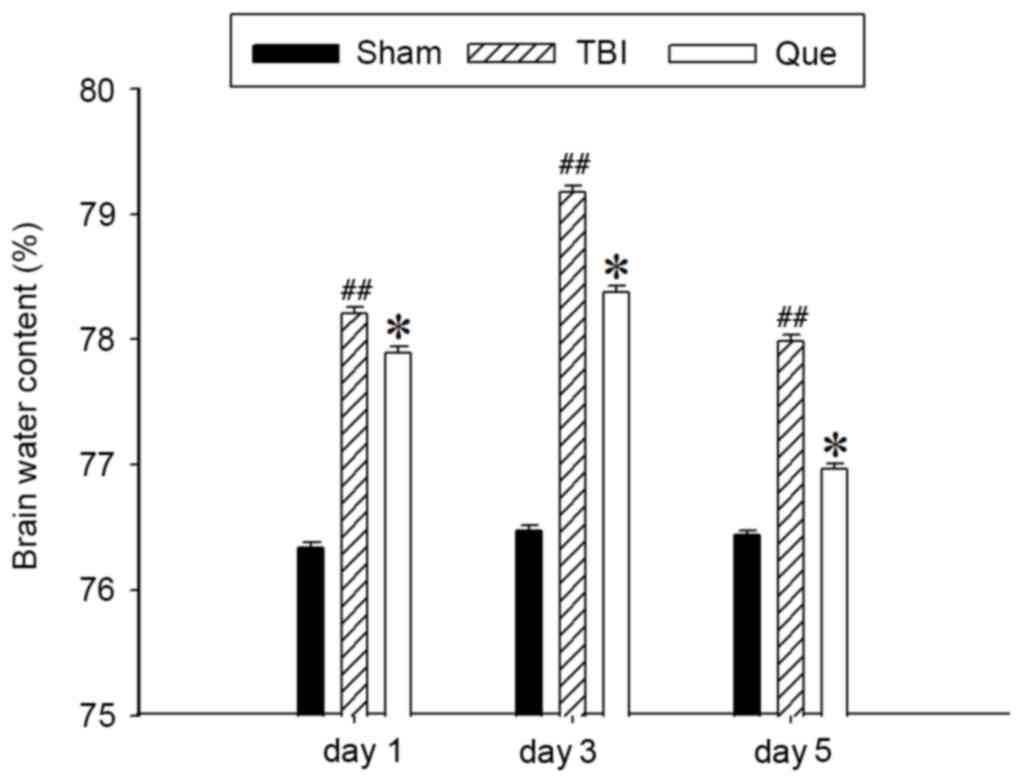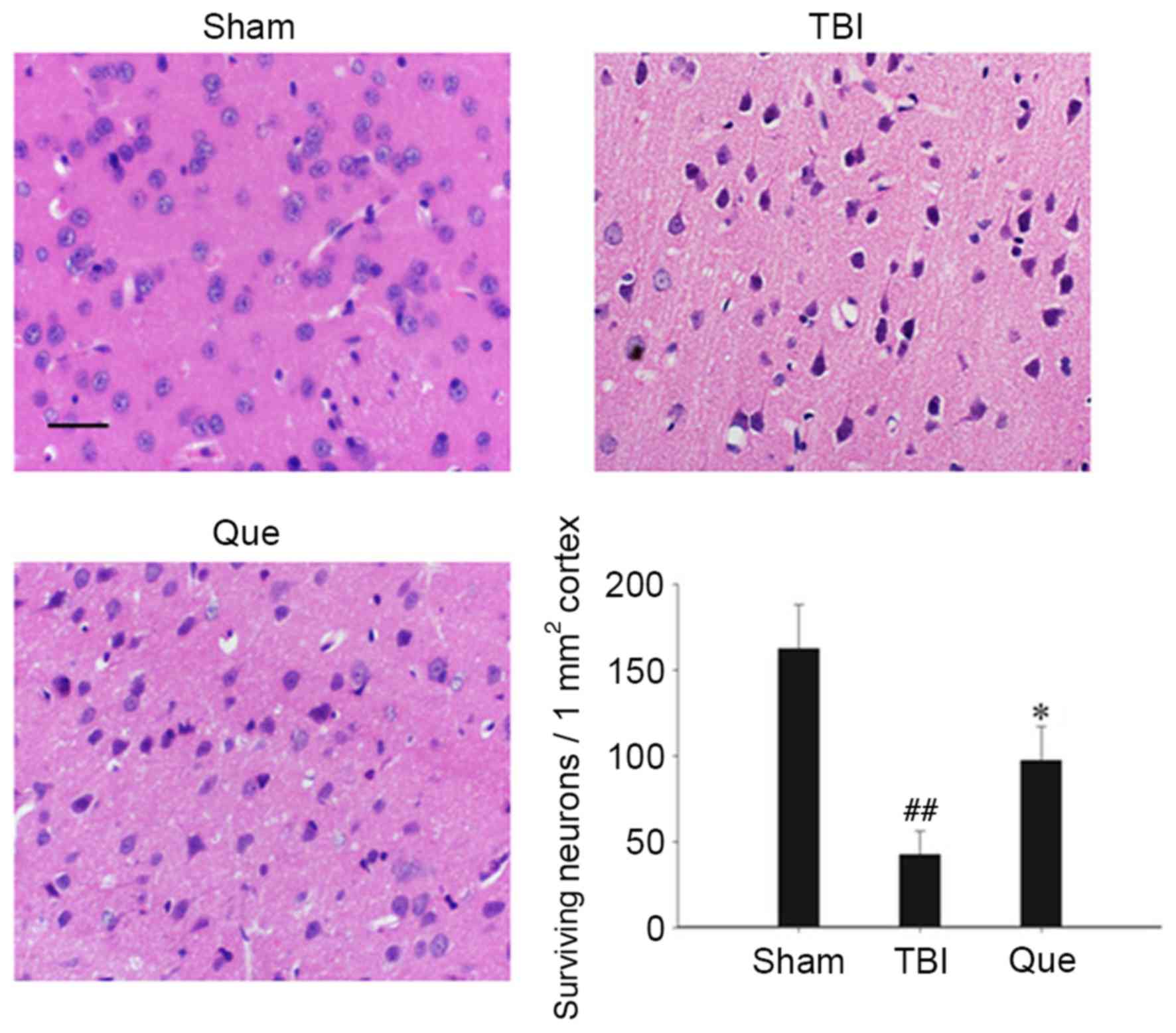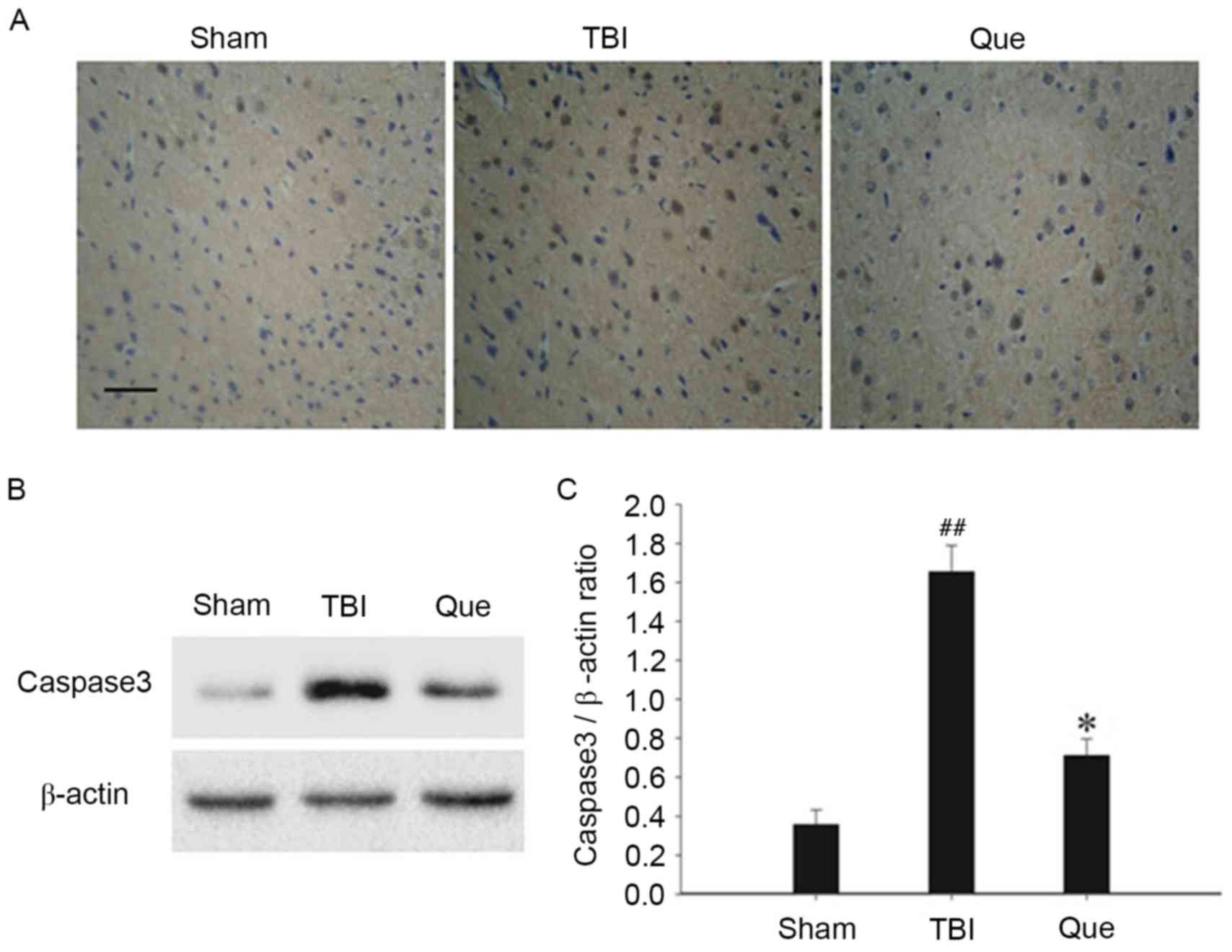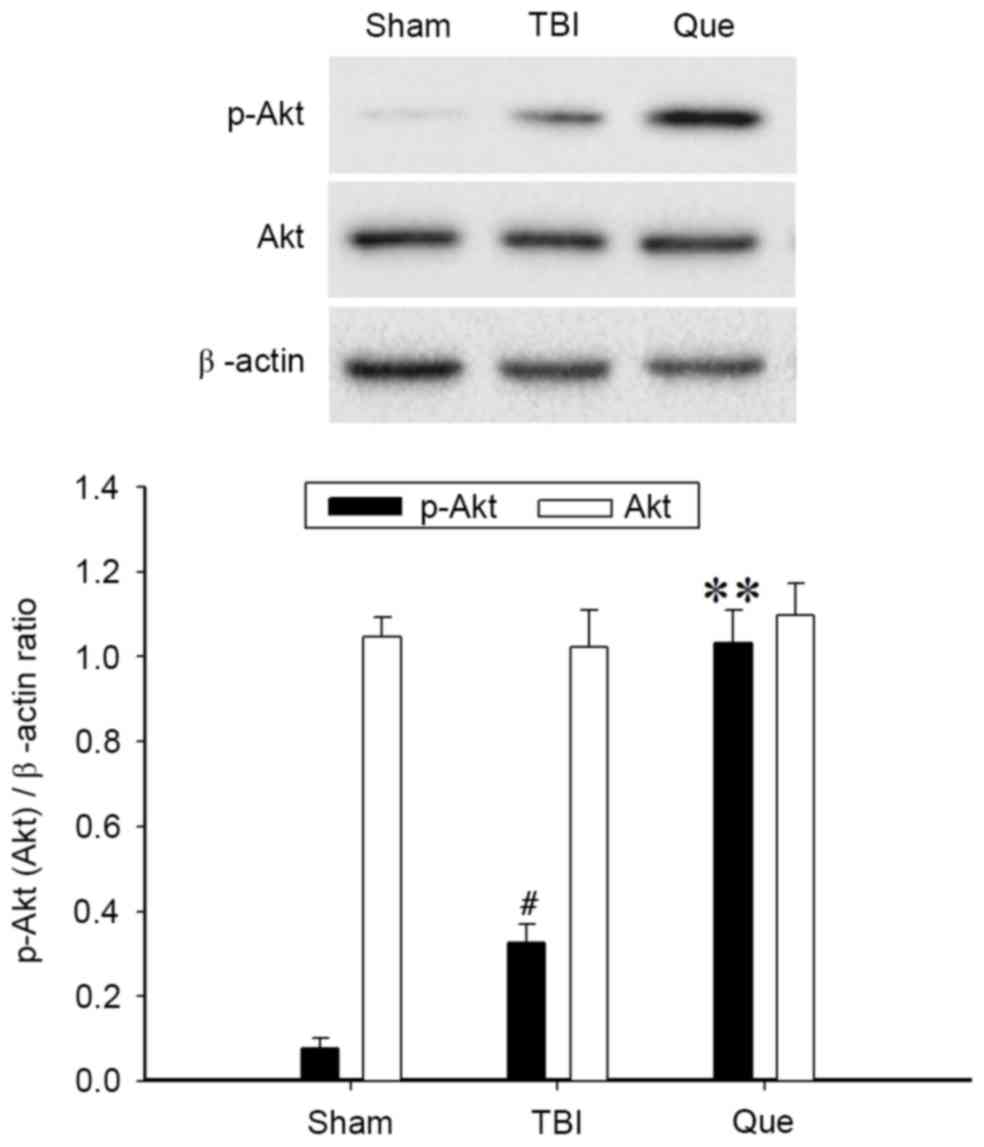Quercetin protects rat cortical neurons against traumatic brain injury
Corrigendum in: /10.3892/mmr.2022.12732
- Authors:
- Published online on: March 28, 2018 https://doi.org/10.3892/mmr.2018.8801
- Pages: 7859-7865
Abstract
Introduction
Traumatic brain injury (TBI) is a leading cause of mortality and morbidity worldwide (1). TBI patients suffer permanent neurological and psychological disabilities that represent a significant social and economic burden. TBI-induced deficits are due to primary (mechanical impact) and secondary (delayed) injuries. It is essential to elucidate the biological cascades that drive the delayed secondary phase subsequent to TBI (2). Despite considerable progress being made in animal models and preclinical research in recent years, there are currently no available therapeutic strategies in clinical practice for TBI.
The flavonoid quercetin (3,5,7,30,40-pentahydroxyflavone), one of the most widely distributed flavonoids in fruits and vegetables, is known to be a potent anti-oxidant and free radical scavenger (3). A number of studies have demonstrated that quercetin possesses anti-inflammatory, anti-coagulation, anti-ischemic and anti-cancer activities (4–6). In addition, Yang et al (7) suggested that in TBI rats, quercetin improves cognitive function owing to its neuroprotective action via the inhibition of oxidative stress, leading to a reduced inflammatory response, thereby reducing neuronal death. It was hypothesized that post-injury treatment with quercetin may exert a therapeutic effect against TBI. Our previous study (8) provided results similar to Yang, however, the specific molecular mechanisms requires further study. The present study also analyzed the expression of Akt serine/threonine protein kinase, phosphorylated (p)-Akt, extracellular signal-regulated kinase (ERK)1/2 and p-ERK1/2 in injured neurons in the cortex, which serves an important role in signal transduction following TBI. The aim of the present study was to investigate the protective effects of quercetin on neurological impairment and spatial cognitive function after TBI in rat model. It further examined whether quercetin could attenuate neuronal apoptosis via PI3K/Akt and ERK1/2 signaling, thereby reducing brain damage.
Materials and methods
Animals
The Institutional Animal Care and Use Committee of Hebei Medical University (Shijiazhuang, China) approved all experiments, which were performed according to the guidelines of the National Institutes of Health (NIH) Guide for the Care and Use of Laboratory Animals (NIH Publications no. 80–23, revised 1978; NIH, Bethesda, MD, USA). All efforts were made to minimize the number of animals used and their suffering. A total of 75 male Sprague Dawley rats, weighing 280–320 g (6–8 weeks), were supplied from the Experimental Animal Center of Hebei Medical University (Shijiazhuang, Hebei, China). All animals were housed in plastic boxes at a temperature of 22–24°C, 50% humidity and were provided food and water ad libitum under a 12-h reversed light-dark cycle.
Model of TBI
The TBI model was produced using a modified weight-drop device (9). Following 10% chloral hydrate anesthesia (3 ml/kg), a midline longitudinal incision was performed to expose the skull between bregma and lambda suture lines. A steel disk (diameter, 10 mm; thickness, 3 mm) was adhered to the skull using dental acrylic. Animals were moved onto a foam mattress underneath a weight-drop device where a weight of 450 g fell freely through a vertical tube from 1.5 m onto the steel disk. Sham-operated animals underwent the same surgical procedure without weight-drop impact. Rats were placed on heat pads (37°C) for 2–4 h to maintain normal body temperature during the recovery period.
Groups and drug administration
All rats were randomly arranged into 3 groups as follows: Sham group (n=25); TBI group (n=25); and TBI + quercetin group (Que; n=25). Quercetin (Sigma-Aldrich; Merck KGaA, Darmstadt, Germany; dissolved in 0.9% saline solution) was administered intraperitoneally at a dose of 50 mg/kg at 30 min, 12 and 24 h following the TBI insult.
In addition, 15 rats (5/group) underwent behavioral testing. All investigations were blinded and the animal groupings were revealed only at the end of the behavioral and histological analyses.
Evaluation of brain edema
Brain water content was determined at day 1, 3 and 5 following TBI (45 rats, 15/group). In order to reduce the use of animal population, at 5 days after TBI, 15 rat brains were taken from rats which had completed the behavioral experiments. Rat brains were separated and weighed immediately with a chemical balance to obtain the wet weight (WW). Following drying in a desiccating oven for 24 h at 100°C, dry tissues were weighed again to obtain the constant dry weight (DW). The percentage of water in the tissues was calculated according to the following formula: brain water (%)=[(WW-DW)/WW] ×100.
Recovery of motor function
The neurobehavioral status of the rats was evaluated at day 1, 3 and 5 after TBI using a set of 10 tasks, collectively termed the Neurological Severity Score (NSS) (10), which test reflexes, alertness, coordination and motor abilities. A point is awarded for failure to perform a particular task; therefore, a score of 10 reflects maximal impairment, whereas a healthy rat scores 0. Post-injury, NSS was evaluated at day 1, 3 and 5. Each animal was assessed by an observer who was blinded to the treatment group of the animal. The difference between the initial NSS (performed at day 1) and that at any subsequent time point was calculated for each rat, and this value (ΔNSS) reflects the spontaneous or treatment-induced recovery of motor function.
Hematoxylin and eosin (H&E) staining and neuron count
At 24 h post-TBI, 15 rats (5/group) were anesthetized as described above, and perfused intracardially with isotonic sodium chloride solution, followed by 4% (w/v) paraformaldehyde in 0.1M sodium phosphate buffer (pH=7.4). The brains were removed and fixed for 48 h in 4% (w/v) paraformaldehyde at 22–24°C. Following fixation, brains were embedded in paraffin, and sliced into 6 µm coronal sections at the level of the bregma and stained with hematoxylin (20 min) and eosin (3 sec) at 22–24°C. The staining was visualized by light microscopy at ×400 magnification (Olympus Corporation, Tokyo, Japan). The surviving and dying neurons per mm2 cortex were quantified (the nuclei of dead cells were shrunk and thickened).
Immunohistochemical
As for HE staining, the brain tissues were fixed, embedded and cut into 6 µm slices. Sections were deparaffinized with xylene and rehydrated at 60°C with graded ethanol (100, 95, 90, 80 and 70%). Endogenous peroxidase activity was blocked using 3% hydrogen peroxide for 30 min at room temperature, followed by 5% normal goat serum (AR0009; Wuhan Boster Biological Technology, Ltd., Wuhan, China) for 1 h to block non-specific protein interactions. The sections were subsequently incubated overnight at 4°C with an anti-activated caspase3 antibody (1:500; AB2302; Abcam, Cambridge, UK). Following three washes with PBS, the slides were incubated with a biotinylated goat anti-mouse horseradish peroxidase conjugated secondary antibody (1:100, BA1051; Wuhan Boster Biological Technology Ltd.) for 2 h at room temperature. The sections were washed with PBS again, and incubated with the kit-provided horseradish peroxidase (HRP)-streptavidin for 30 min at room temperature. The peroxidase reaction was visualized using 0.05% diaminobenzidine + 0.01% hydrogen peroxide. Immunohistochemical procedures were performed in accordance with the manufacturer's protocols. The positive cells were visualized by a microscope at ×100 magnification.
Western blotting
The rats were deeply anesthetized as described above 24 h following TBI. The cortical region of the rat brain was rapidly isolated. The segments were immediately stored at −80°C for further analysis. Total protein samples were extracted from brain tissues using whole cell lysis buffer (WD2072; Beyotime Institute of Biotechnology, Shanghai, China) a bicinchoninic acid protein assay kit (P10310; Beyotime Institute of Biotechnology) was used to determine the protein concentration of each sample. The homogenate was heated to 100°C for 10 min and centrifuged again at 15,294 × g for 1 min at 22–24°C. Equal amounts (80 µg) of protein were subjected to Tris-HCl SDS-PAGE on 8 and 12% gels (Bio-Rad Laboratories, Inc., Hercules, CA, USA) for 30 min at 70 V and 60 min at 120 V. Following electrophoresis, the proteins were transferred onto polyvinylidene fluoride membranes (EMD Millipore, Billerica, MA, USA) at 300 mA for immunoblotting. Following blocking with 5% skimmed milk for 2 h at room temperature, membranes were incubated overnight at 4°C with the following primary antibodies: Rabbit anti-activated Caspase3 (AB2302; 1:1,000; Abcam), rabbit anti-Akt (AB81283; 1:1,000; Abcam), rabbit anti-p-Akt (AB38449; 1:1,000; Abcam), rabbit anti-ERK1/2 (AB17942; 1:1,000; Abcam), rabbit anti-p-ERK1/2 (AB214362; 1:1,000; Abcam), and rabbit anti-β-actin (AB227387; 1:5,000; Abcam). Following three washes in TBS-Tween 20, membranes were incubated with a horseradish peroxidase-conjugated goat anti-rabbit immunoglobulin G (BL003A; 1:5,000; EMD Millipore) for 2 h at room temperature. Protein bands were visualized using an enhanced chemiluminescence kit (Beyotime Institute of Biotechnology). Band density was quantified via detection with a DNR Micro Chemi chemiluminescence gel imaging system (DNR Bio-Imaging Systems Ltd., Neve Yamin, Israel). Each band density was normalized to the density of β-actin.
Statistical analysis
SPSS software version 16.0 (SPSS, Inc., Chicago, IL, USA) was used for statistical analysis. A statistical evaluation of the data was performed using a one-way analysis of variance, followed by post hoc comparisons using the least significant difference or Kruskal-Wallis method. All experimental data are expressed as the mean ± standard error of the mean, and P<0.05 was considered to indicate a statistically significant difference.
Results
Quercetin attenuates TBI-induced cerebral edema
Following injury, brain edema leads to an elevation in intracranial pressure, reducing cerebral perfusion pressure and brain oxygenation. Edema is associated with the resultant pathology following TBI (11). In order to evaluate the effects of quercetin on brain edema, the wet-dry weight method was used in the present study to evaluate brain edema at day 1, 3 and 5 after TBI. As presented in Fig. 1, cerebral water content was significantly increased at day 1, 3 and 5 after TBI compared with the sham group (P<0.01). However, treatment with quercetin attenuated this increased compared with the TBI model group (P<0.05).
Quercetin attenuates TBI-induced motor deficits
Motor deficit recovery was expressed as ΔNSS in present study. Alterations in the functional recovery of rats at day 1, 3 and 5 are depicted in Fig. 2. It was observed that rats exhibited marked motor deficits following TBI. Post-injury administration of quercetin significantly improved the motor function between day 1 and 5 after trauma compared with the TBI group (P<0.05).
Quercetin increases neuronal survival in the cortical region of brain
Cortical regions of brains were collected and neuronal survival was assessed at 24 h via H&E staining. As presented in Fig. 3, the nuclei of normal neurons were round and stained pale, whereas nuclei of dying neurons were pyknotic and darkly stained following TBI. The survival rate of neurons in the quercetin-treated group was significantly improved compared with that of the TBI group (P<0.05).
Quercetin attenuates neuronal apoptosis in the cortex
In order to assess the effect of quercetin on neuronal apoptosis following TBI, immunohistochemical and western blot analyses were used to assess alterations in caspase3 expression, respectively. As depicted in Fig. 4A, representative photomicrographs exhibited a high density of caspase3-positive cells in the TBI group compared with the sham group at 24 h. However, the expression of activated caspase3-positive cells notably decreased in the quercetin treatment group. In addition, western blot analysis revealed that, compared with the sham group, the protein expression levels of activated caspase3 increased significantly in the TBI group at 24 h (P<0.01), and the levels of caspase3 exhibited a significant downregulation at the same time point following treatment with quercetin (P<0.05; Fig. 4B and C).
Quercetin induces the activation of the Akt signaling pathway in the cortex following TBI
Western blot analysis was performed to investigate the expression of Akt and p-Akt at 24 h after TBI in the 3 groups. As presented in Fig. 5, the level of p-Akt was increased following TBI compared with that in the sham group (P<0.05). Additionally, administration of quercetin produced a significant elevation of p-Akt (P<0.01). No significant difference in total Akt protein expression was observed among the 3 groups.
Quercetin attenuates the ERK1/2 signaling pathway following TBI
Western blot analysis was performed to investigate the expression of ERK1/2 and p-ERK1/2 at 24 h after TBI in the 3 groups. As presented in Fig. 6, the level of p-ERK1/2 was increased significantly post-TBI, compared with the sham group (P<0.01). However, the administration of quercetin produced a significant attenuation of p-ERK1/2 levels compared with the TBI group (P<0.01). No significant difference in total ERK1/2 protein expression was observed among the 3 groups.
Discussion
The aim of the present study was to investigate the neuroprotective effects of quercetin on TBI. H&E staining is a macroscopic and readily available method to assess histopathological changes. Quercetin treatment notably attenuated injury. In the Que group, the structure of the brain tissue was improved and the number of neurons increased compared with the TBI group. In addition, TBI-induced neurological deficits and brain edema was suppressed by treatment with quercetin. At the molecular level, treatment with quercetin significantly inhibited the TBI-induced expression of cleaved Caspase3. It was additionally observed that the neuroprotective effects of the drug were associated with activation of the Akt signaling pathway, and inhibition of the ERK signaling pathway. The results of the present study were consistent with previous studies demonstrating that quercetin may exert neuroprotection in various in vitro and in vivo models (12–15). Therefore, it is hypothesized that quercetin may have the potential to become a novel therapeutic for TBI.
The primary injury occurs at the moment of TBI impact, with disruption of the blood brain barrier and blood vessels that contribute to immediate (necrotic) cell death (16). Subsequently, oxygen free radical-mediated lipid peroxidation, inflammation and brain edema appear to be fundamental mechanisms underlying secondary damage in TBI (17). In the present study, caspase3 was induced by TBI, which is a key executor in the process of apoptosis in neurons (18). However, treatment with quercetin significantly inhibited the TBI-induced expression of cleaved caspase3. These observations were consistent with a previous study, which demonstrated that caspase3 immunoreactivity was reduced by quercetin in the cerebral ischemic penumbra in rats (19). The neuroprotective effect of quercetin was associated with the inhibition of neuronal apoptosis.
Akt, also termed protein kinase B, is a serine/threonine kinase with pro-survival functions in acute brain injury (20). Extracellular signals frequently result in the simultaneous activation of the PI3K/Akt signaling pathway, and a number of reports have suggested a survival role of the PI3K/Akt signaling pathway through the suppression of apoptosis (21,22). Additionally, previous studies have demonstrated that the intrinsic pathway is characterized by mitochondrial outer membrane permeabilization, death-inducible signaling complex formation, DNA fragmentation and caspase3 activation. These events have been demonstrated to be associated with ERK1/2 signaling pathway activation (23,24). In the present study, treatment with quercetin inhibited the TBI-induced activation of the ERK1/2 signaling pathway, and further enhanced the PI3K/Akt pathway in TBI-injured neurons. Therefore, the neuroprotective effects of quercetin may be associated with ERK1/2 inhibition in addition to PI3K/Akt activation.
Previous studies have showed that in TBI rats, quercetin improves cognitive function due to its neuroprotective action via the inhibition of oxidative stress, leading to a reduced inflammatory response and thereby reducing neuronal death (7,8). Compared with other studies, the present study performed a more in-depth study on the molecular mechanism of the neuroprotection effects of quercetin. It was demonstrated that post-TBI administration of quercetin may attenuate brain edema and improve motor functions in rats. In addition, quercetin caused marked ERK1/2 inhibition and PI3K/Akt activation, and thereby attenuation of neuronal apoptosis. The present study provides novel insight into the mechanisms through which quercetin may exert its neuroprotective activity in a rat model of TBI.
Acknowledgements
Not applicable.
Funding
No funding was received.
Availability of data and materials
All datasets on which the conclusions are based are provided in the present article.
Authors' contributions
GD, ZZ and YC designed the present study. ZoL, YT and ZhL performed the experiments. BL and JS analyzed and interpreted data, and were major contributors in writing the manuscript. All authors read and approved the final manuscript.
Ethics approval and consent to participate
The Institutional Animal Care and Use Committee of Hebei Medical University (Shijiazhuang, China) approved all experiments, which were performed according to the guidelines of the National Institutes of Health (NIH) Guide for the Care and Use of Laboratory Animals (NIH Publications no. 80–23, revised 1978; NIH, Bethesda, MD, USA). All efforts were made to minimize the number of animals used and their suffering.
Consent for publication
Not applicable.
Competing interests
The authors declare that they have no competing interests.
Glossary
Abbreviations
Abbreviations:
|
TBI |
traumatic brain injury |
|
NSS |
neurological severity score |
|
Que |
quercetin-treated |
|
WW |
wet weight |
|
DW |
dry weight |
|
H&E |
hematoxylin and eosin |
|
PI3K |
phosphatidylinositol 3-kinase |
|
Akt |
Akt serine/threonine protein kinase |
|
ERK |
extracellular signal-regulated kinase |
References
|
Ye X, Asim M and Michael C: Animal models of traumatic brain injury. Nat Rev Neurosci. 14:128–142. 2013. View Article : Google Scholar : PubMed/NCBI | |
|
Carroll LJ, Cassidy JD, Cancelliere C, Côté P, Hincapié CA, Kristman VL, Holm LW, Borg J, Nygren-de Boussard C and Hartvigsen J: Systematic review of the prognosis after mild traumatic brain injury in adults: Cognitive, psychiatric, and mortality outcomes: Results of the international collaboration on mild traumatic brain injury prognosis. Arch Phys Med Rehabil. 95 3 Suppl:S152–S173. 2014. View Article : Google Scholar : PubMed/NCBI | |
|
Verma AK and Pratap R: The biological potential of flavones. Nat Prod Rep. 27:1571–1593. 2010. View Article : Google Scholar : PubMed/NCBI | |
|
Legault J, Perron T, Mshvildadze V, Girard-Lalancette K, Perron S, Laprise C, Sirois P and Pichette A: Antioxidant and anti-inflammatory activities of quercetin 7-O-β-D-glucopyranoside from the leaves of Brasenia schreberi. J Med Food. 14:1127–1134. 2011. View Article : Google Scholar : PubMed/NCBI | |
|
Zhang H, Zhang M, Yu L, Zhao Y, He N and Yang X: Antitumor activities of quercetin and quercetin-5,8-disulfonate in human colon and breast cancer cell lines. Food Chem Toxicol. 50:1589–1599. 2012. View Article : Google Scholar : PubMed/NCBI | |
|
Dok-Go H, Lee KH, Kim HJ, Lee EH, Lee J, Song YS, Lee YH, Jin C, Lee YS and Cho J: Neuroprotective effects of antioxidative flavonoids, quercetin, (+)-dihydroquercetin and quercetin 3-methyl ether, isolated from Opuntia ficus-indica var. saboten. Brain Res. 965:130–136. 2003. View Article : Google Scholar : PubMed/NCBI | |
|
Yang T, Kong B, Gu JW, Kuang YQ, Cheng L, Yang WT, Xia X and Shu HF: Anti-apoptotic and anti-oxidative roles of quercetin after traumatic brain injury. Cell Mol Neurobiol. 34:797–804. 2014. View Article : Google Scholar : PubMed/NCBI | |
|
Du G, Zhao Z, Chen Y, Li Z, Tian Y, Liu Z, Liu B and Song J: Quercetin attenuates neuronal autophagy and apoptosis in rat traumatic brain injury model via activation of PI3K/Akt signaling pathway. Neurol Res. 1–8. 2016.(Epub ahead of print). PubMed/NCBI | |
|
Marmarou A, Foda AE, van den Brink W, Campbell J, Kita H and Demetriadou K: A new model of diffuse brain injury in rats. Part I: Pathophysiology and biomechanics. J Neurosurg. 80:291–300. 1994. View Article : Google Scholar : PubMed/NCBI | |
|
Chen Y, Constantini S, Trembovler V, Weinstock M and Shohami E: An experimental model of closed head injury in mice: Pathophysiology, histopathology, and cognitive deficits. J Neurotrauma. 13:557–568. 1996.PubMed/NCBI | |
|
Donkin JJ and Vink R: Mechanisms of cerebral edema in traumatic brain injury: Therapeutic developments. Curr Opin Neurol. 23:293–299. 2010. View Article : Google Scholar : PubMed/NCBI | |
|
Zhang ZJ, Cheang LC, Wang MW and Lee SM: Quercetin exerts a neuroprotective effect through inhibition of the iNOS/NO system and pro-inflammation gene expression in PC12 cells and in zebrafish. Int J Mol Med. 27:195–203. 2011.PubMed/NCBI | |
|
Kumar B, Gupta SK, Nag TC, Srivastava S, Saxena R, Jha KA and Srinivasan BP: Retinal neuroprotective effects of quercetin in streptozotocin-induced diabetic rats. Exp Eye Res. 125:193–202. 2014. View Article : Google Scholar : PubMed/NCBI | |
|
Pu F, Mishima K, Irie K, Motohashi K, Tanaka Y, Orito K, Egawa T, Kitamura Y, Egashira N, Iwasaki K and Fujiwara M: Neuroprotective effects of quercetin and rutin on spatial memory impairment in an 8-arm radial maze task and neuronal death induced by repeated cerebral ischemia in rats. J Pharmacol Sci. 104:329–334. 2007. View Article : Google Scholar : PubMed/NCBI | |
|
Silva B, Oliveira PJ, Dias A and Malva JO: Quercetin, kaempferol and biapigenin from Hypericum perforatum are neuroprotective against excitotoxic insults. Neurotox Res. 13:265–279. 2008. View Article : Google Scholar : PubMed/NCBI | |
|
Eucker SA, Smith C, Ralston J, Friess SH and Margulies SS: Physiological and histopathological responses following closed rotational head injury depend on direction of head motion. Exp Neurol. 227:79–88. 2011. View Article : Google Scholar : PubMed/NCBI | |
|
Feng JF, Gurkoff GG, Van KC, Song M, Lowe DA, Zhou J and Lyeth BG: NAAG peptidase inhibitor reduces cellular damage in a model of TBI with secondary hypoxia. Brain Res. 1469:144–152. 2012. View Article : Google Scholar : PubMed/NCBI | |
|
Clark RS, Kochanek PM, Watkins SC, Chen M, Dixon CE, Seidberg NA, Melick J, Loeffert JE, Nathaniel PD, Jin KL and Graham SH: Caspase-3 mediated neuronal death after traumatic brain injury in rats. J Neurochem. 74:740–753. 2000. View Article : Google Scholar : PubMed/NCBI | |
|
Yao RQ, Qi DS, Yu HL, Liu J, Yang LH and Wu XX: Quercetin attenuates cell apoptosis in focal cerebral ischemia rat brain via activation of BDNF-TrkB-PI3K/Akt signaling pathway. Neurochem Res. 37:2777–2786. 2012. View Article : Google Scholar : PubMed/NCBI | |
|
Endo H, Nito C, Kamada H, Yu F and Chan PH: Akt/GSK3beta survival signaling is involved in acute brain injury after subarachnoid hemorrhage in rats. Stroke. 37:2140–2146. 2006. View Article : Google Scholar : PubMed/NCBI | |
|
Park KR, Nam D, Yun HM, Lee SG, Jang HJ, Sethi G, Cho SK and Ahn KS: β-Caryophyllene oxide inhibits growth and induces apoptosis through the suppression of PI3K/AKT/mTOR/S6K1 pathways and ROS-mediated MAPKs activation. Cancer Lett. 312:178–188. 2011. View Article : Google Scholar : PubMed/NCBI | |
|
Li WX, Chen SF, Chen LP, Yang GY, Li JT, Liu HZ and Zhu W: Thimerosal-induced apoptosis in mouse C2C12 myoblast cells occurs through suppression of the PI3K/Akt/survivin pathway. PLoS One. 7:e490642012. View Article : Google Scholar : PubMed/NCBI | |
|
Yan L, Tang Q, Shen D, Peng S, Zheng Q, Guo H, Jiang M and Deng W: SOCS-1 inhibits TNF-alpha-induced cardiomyocyte apoptosis via ERK1/2 pathway activation. Inflammation. 31:180–188. 2008. View Article : Google Scholar : PubMed/NCBI | |
|
Chong YH, Shin YJ, Lee EO, Kayed R, Glabe CG and Tenner AJ: ERK1/2 activation mediates Abeta oligomer-induced neurotoxicity via caspase-3 activation and tau cleavage in rat organotypic hippocampal slice cultures. J Biol Chem. 281:20315–20325. 2006. View Article : Google Scholar : PubMed/NCBI |















